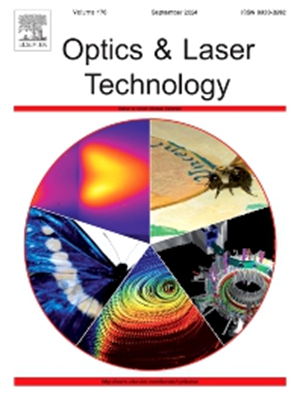猝发模式皮秒激光烧蚀 316 不锈钢时脉冲内数的影响:实验和数值建模
IF 5
2区 物理与天体物理
Q1 OPTICS
引用次数: 0
摘要
本文报道了10ps激光烧蚀316l不锈钢的实验和数值分析。本研究通过实验揭示了脉冲数Nint(1-5)对烧蚀阈值和烧蚀深度的影响,并采用双温模型(TTM)结合材料去除法预测了脉冲爆发烧蚀过程中的横向温度和烧蚀分布。随着Nint的增大,脉冲内消融阈值Fint减小,消融深度Dexp增大。数值计算结果与实验数据吻合较好,并假设热积累是主要机理。然而,熔融和热应力在Nint >;3导致在Nint = 5处最大的环状凸起。研究结果不仅突出了脉冲内数对烧蚀效率的重要性,而且为皮秒激光烧蚀中MHz突发模式的物理特性提供了新的认识。本文章由计算机程序翻译,如有差异,请以英文原文为准。
The effect of intra-pulse number during burst mode picosecond laser ablation of 316 stainless steel: Experimental and numerical modelling
An experimental and numerical analysis of 10 ps laser ablation on 316 L stainless steel at 100 KHz with 30 MHz intra-burst frequency and varying intra-burst number is reported. This research experimentally revealed how intra-pulse number Nint (1–5) influences the ablation threshold and ablation depth while a Two-Temperature Model (TTM) coupled with material removal method is used to predict the transverse temperature and ablation profile during pulse burst ablation. It was found that the intra-pulse ablation threshold Fint decreases and ablated depth Dexp increases with increasing Nint. The numerical results align well with the experimental data, assuming that the heat accumulation is the main mechanism. However, melting and thermal stress is more pronounced when Nint > 3 resulting in the highest annular bulge at Nint = 5. The results not only highlight the importance of intra-pulse number on the ablation efficiency, but also provide an insight into the physics of MHz burst mode in picosecond laser ablation.
求助全文
通过发布文献求助,成功后即可免费获取论文全文。
去求助
来源期刊
CiteScore
8.50
自引率
10.00%
发文量
1060
审稿时长
3.4 months
期刊介绍:
Optics & Laser Technology aims to provide a vehicle for the publication of a broad range of high quality research and review papers in those fields of scientific and engineering research appertaining to the development and application of the technology of optics and lasers. Papers describing original work in these areas are submitted to rigorous refereeing prior to acceptance for publication.
The scope of Optics & Laser Technology encompasses, but is not restricted to, the following areas:
•development in all types of lasers
•developments in optoelectronic devices and photonics
•developments in new photonics and optical concepts
•developments in conventional optics, optical instruments and components
•techniques of optical metrology, including interferometry and optical fibre sensors
•LIDAR and other non-contact optical measurement techniques, including optical methods in heat and fluid flow
•applications of lasers to materials processing, optical NDT display (including holography) and optical communication
•research and development in the field of laser safety including studies of hazards resulting from the applications of lasers (laser safety, hazards of laser fume)
•developments in optical computing and optical information processing
•developments in new optical materials
•developments in new optical characterization methods and techniques
•developments in quantum optics
•developments in light assisted micro and nanofabrication methods and techniques
•developments in nanophotonics and biophotonics
•developments in imaging processing and systems

 求助内容:
求助内容: 应助结果提醒方式:
应助结果提醒方式:


